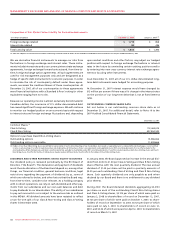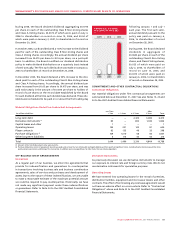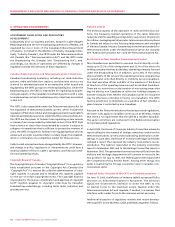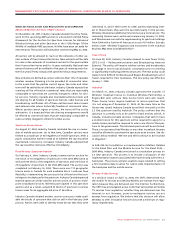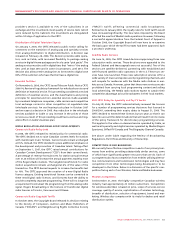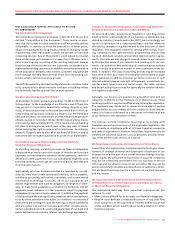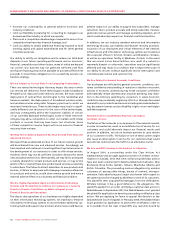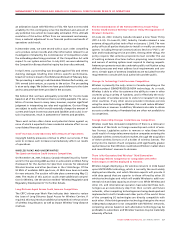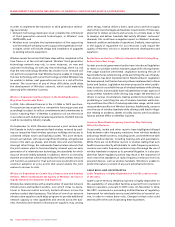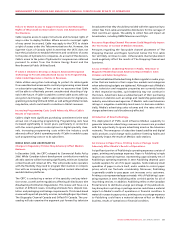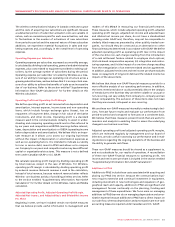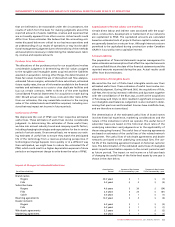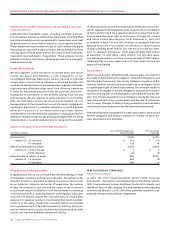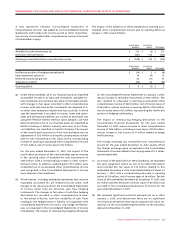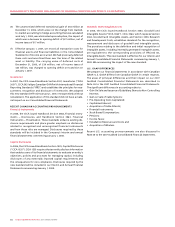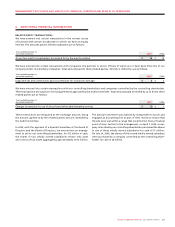Rogers 2007 Annual Report Download - page 62
Download and view the complete annual report
Please find page 62 of the 2007 Rogers annual report below. You can navigate through the pages in the report by either clicking on the pages listed below, or by using the keyword search tool below to find specific information within the annual report.
58 ROGERS COMMUNICATIONS INC. 2007 ANNUAL REPORT
MANAGEMENT’S DISCUSSION AND ANALYSIS OF FINANCIAL CONDITION AND RESULTS OF OPERATIONS
In order to implement the transition to third generation technol-
ogy successfully:
• Networktechnologydevelopersmustcompletetherenement
of third generation network technologies, in Wireless’ case
UMTS/HSPA; and
• Wirelessmustcompletetheimplementationofthesupporting
wireline network infrastructure to support third generation tech-
nologies, which will include design and installation of upgrades
to existing network equipment.
Wireless cannot be certain that these steps will be completed in the
time frame or at the cost anticipated. Wireless’ third generation
technology network may rely, in some instances, on new and
unproven technology. As with any new technology, there is a risk
that the new technology Wireless has chosen for its network will
not perform as expected, that Wireless may be unable to integrate
the new technology with current technology and that Wireless may
be unable to deliver next generation services in a cost-effective
manner. The occurrence of any of these difficulties could delay
the development of Wireless’ network, which could materially
adversely affect Wireless’ business.
Wireless’ Expansion and Investment in the Inukshuk Business
May Have Considerable Risks.
In 2000, Fido obtained licences in the 2.5 MHz or MCS spectrum.
This spectrum was acquired in a competitive licencing process and
accordingly is subject to rollout commitments and commitments to
fund a “Learning Plan”. If Wireless is unable to roll out the service
in accordance with Industry Canada requirements, the MCS licences
could be revoked by Industry Canada.
On September 16, 2005, Wireless announced a joint venture with
Bell Canada to build a nationwide fixed wireless network by pool-
ing our respective fixed wireless spectrum holdings and access to
combined cellular tower and backhaul assets. This joint venture,
known as Inukshuk, will require significant funding, will generate
losses in the start-up phases, and entails risks and uncertainties.
Amongst other things, the nationwide fixed wireless network that
the joint venture plans to fund and deploy is based upon an early
generation of a relatively new technology, the standards for which
may not become widely adopted. In addition, there is no certainty
that the services that will be enabled by the fixed wireless network
will function as planned or that such services would attract wide
customer adoption at price points that would enable the joint
venture to recover its costs.
Wireless is Dependent on Certain Key Infrastructure and Handset
Vendors, Which Could Impact the Quality of Wireless’ Services or
Impede Network Development and Expansion.
Wireless has relationships with a small number of essential network
infrastructure and handset vendors, over which it has no opera-
tional or financial control and only limited influence in how the
vendors conduct their businesses. The failure of one of our network
infrastructure suppliers could delay programs to provide additional
network capacity or new capabilities and services across the busi-
ness. Handsets and network infrastructure suppliers may, among
other things, extend delivery times, raise prices and limit supply
due to their own shortages and business requirements. If these sup-
pliers fail to deliver products and services on a timely basis or fail
to develop and deliver handsets that satisfy Wireless’ customers’
demands, this could have a negative impact on Wireless’ business,
financial condition and results of operations. Similarly, interruptions
in the supply of equipment for our networks could impact the
quality of Wireless’ service or impede network development and
expansion.
Restrictions on the Use of Wireless Handsets While Driving May
Reduce Subscriber Usage.
Certain provincial government bodies have introduced legislation
to restrict or prohibit wireless handset usage while driving (hands-
free usage would be permitted). Legislation banning the use of
hand-held phones while driving, while permitting the use of hands-
free devices, has been implemented in Newfoundland. Legislation
has been passed, but the ban has not yet been implemented, in Nova
Scotia and Québec. Legislation has been proposed in other jurisdic-
tions to restrict or prohibit the use of wireless handsets while driving
motor vehicles. Some studies have indicated that certain aspects of
using wireless handsets while driving may impair the attention of
drivers in various circumstances, making accidents more likely. Laws
prohibiting or restricting the use of wireless handsets while driv-
ing could have the effect of reducing subscriber usage, which could
cause an adverse effect on Wireless’ business. Additionally, concerns
over the use of wireless handsets while driving could lead to litiga-
tion relating to accidents, deaths or bodily injuries, which could also
have an adverse effect on Wireless’ business.
Concerns About Radio Frequency Emissions May Adversely
Affect Our Business.
Occasionally, media and other reports have highlighted alleged
links between radio frequency emissions from wireless handsets
and various health concerns, including cancer, and interference with
various medical devices, including hearing aids and pacemakers.
While there are no definitive reports or studies stating that such
health issues are directly attributable to radio frequency emissions,
concerns over radio frequency emissions may discourage the use of
wireless handsets or expose us to potential litigation. It is also pos-
sible that future regulatory actions may result in the imposition of
more restrictive standards on radio frequency emissions from low
powered devices, such as wireless handsets. Wireless is unable to
predict the nature or extent of any such potential restrictions.
CABLE RISKS AND UNCERTAINTIES
Cable Telephony is Highly-Dependent on Facilities and Services
of the ILECs.
Cable’s out-of-territory telephony business is highly-dependent on
the availability of unbundled facilities acquired from incumbent
telecom operators, pursuant to CRTC rules. On November 9, 2006,
the CRTC commenced a proceeding entitled Review of regulatory
framework for wholesale services and definition of essential ser-
vice, in order to review these rules. Changes to these rules could
severely affect the cost of operating these businesses.


